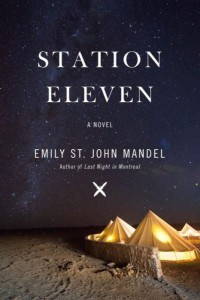Edgy Stuff: May 2015 Recommendations and a New Editor-At-Large

The editorial board is delighted to announce another new member of our team, and our first Editor-At-Large. Kaitlin Stack Whitney is a PhD candidate in the Department of Zoology at UW-Madison. She studies how changes in landscapes and climate affect insect communities and teaches environmental studies through experiential learning, from square dancing to spoken word. This coming year she’ll be a visiting scholar at the Rochester Institute of Technology/National Technical Institute for the Deaf.
In addition, today we offer our monthly recommendations based on the most interesting stuff that’s come across our desks, screens, and speakers. From books and articles, to podcasts, music, and film, we’ll keep you on the edge.
Rachel Boothby
Something about spring invites play, whether it’s post-deadline relief, the otherworldliness of verdant branches raining seedpods onto sidewalks, or the surprise of once-bare bushes bristling with flitting birds. In the spirit of levity, I recommend Italian actress Isabella Rossellini’s remarkable (and remarkably silly) series of short videos on the love lives of animals. Perhaps ease in with her musings on motherly habits of the piping plover or the cuckoo before approaching the more risqué matter of the mating habits of the toad, shrimp, and preying mantis!
Daniel Grant
Matt Black’s Kingdom of Dust photo essays evoke the working-class agricultural landscapes of the ongoing California drought. But his black and white photos portray more than fallowed fields. By focusing on residents of the Central Valley to explore themes of poverty, labor, and dispossession, his work alludes to Dorothea Lange’s Depression-era photography of many of the the same landscapes (made famous by her photo entitled “Migrant Mother“). Black’s photos appear vibrant, stark, and alive in movement, as he accentuates light and shadow with camera equipment that was unavailable to Lange. He shows not only the historical continuities of drought in California, but also the role of photography in integrating the dust of the past with the dust of the present.
Spring Greeney

“Las Vegas Strip at Night (6337511396)” by Marco Verch. Licensed under CC BY 2.0 via Wikimedia Commons.
“So let me confess at the outset to my preference for the real fakery of Las Vegas over the fake reality of Santa Fe—for the genuine rhinestone over the imitation pearl.” If ever I evinced skepticism over Dave Hickey’s assessment of Sin City, let me renege on that judgment here: just returned from a five-day trip to Nevada, I’m simply urging that you, fellow ecological thinkers, find a time to explore this constructed experiment in excess. Pay particular attention to the deliberate soundscaping on The Strip: the speakers built in the curbside flower beds effectively rendered me—embarrassing disclosure—a starlette accompanied by my own personal theme song. It turns out I’m a sucker for glitz, and I suspect I’m not alone in this susceptibility.
Nathan Jandl
In Emily St. John Mandel’s apocalyptic novel, Station Eleven (2014),  a vaguely threatening flu becomes a pandemic of unimaginable proportions, wiping out the majority of the earth’s population in mere weeks. After the worst has passed, a group of survivors forms a traveling orchestra and drama troupe, wandering the American midwest and performing Shakespeare plays in ragged hamlets—”because,” as their sign reads, “survival is insufficient.” The novel is intimately contemporary, far too realistic for comfort, and Mandel’s writing is often remarkably deft. But throughout, I’ve found myself asking, “What about nature?” Station Eleven hardly explores changes in the nonhuman world, except to describe overgrown highways and an increase in visible stars. With about 50 pages to go, I can’t decide if this is the book’s greatest failing or one of its most fundamental claims: that after the end of the world, the reconciliation of human and nonhuman is simply beside the point.
a vaguely threatening flu becomes a pandemic of unimaginable proportions, wiping out the majority of the earth’s population in mere weeks. After the worst has passed, a group of survivors forms a traveling orchestra and drama troupe, wandering the American midwest and performing Shakespeare plays in ragged hamlets—”because,” as their sign reads, “survival is insufficient.” The novel is intimately contemporary, far too realistic for comfort, and Mandel’s writing is often remarkably deft. But throughout, I’ve found myself asking, “What about nature?” Station Eleven hardly explores changes in the nonhuman world, except to describe overgrown highways and an increase in visible stars. With about 50 pages to go, I can’t decide if this is the book’s greatest failing or one of its most fundamental claims: that after the end of the world, the reconciliation of human and nonhuman is simply beside the point.
Rebecca Summer
In the aftermath of the Freddie Gray killing and demonstrations in Baltimore at the end of April, NPR’s Fresh Air turned to Richard Rothstein, a historian who has studied institutionalized residential segregation in this country. This 35-minute interview is a great introduction to some of the twentieth-century housing policies that have shaped the landscapes of racial inequality we see in American urban environments, including Baltimore, today.
Kaitlin Stack Whitney

“Eastern Hellbender (Cryptobranchus alleganiensis)_3,” by Flickr user “guppiecat,” Creative Commons CC BY-NC-ND 2.0 license.
Dragons aren’t real—or are they? The US Forest Service and a film production company, Freshwater Illustrated, would say they might be right under your feet. Their gorgeously shot short, “The Last Dragons,” introduces viewers to the Eastern Hellbender, North America’s own giant salamander. Unfortunately, populations are sharply declining due to changes in water quality. A beautiful, bittersweet musing on some of the unintended consequences of even small-scale landscape changes to the critter most like a dragon in our midst.

You must be logged in to post a comment.